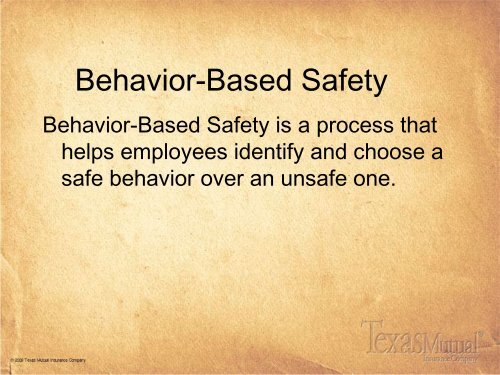Behavior-Based Safety
Behavior-Based Safety
Behavior-Based Safety
You also want an ePaper? Increase the reach of your titles
YUMPU automatically turns print PDFs into web optimized ePapers that Google loves.
Basic <strong>Behavior</strong> Principles<strong>Safety</strong> in the workplace is a combinationof three measurable components: theperson, their environment, and theirbehavior.Only when these three elements arecombined can workplace accidents beeliminated.
Basic <strong>Behavior</strong> PrinciplesThe person component consist of theemployees:• Physical capabilities• Experience, and• Training
Basic <strong>Behavior</strong> PrinciplesThe work environment represents:• Engineering Controls,• Equipment,• Job task, and• The work culture
Basic <strong>Behavior</strong> Principles• The final, most often overlookedcomponent is behavior—what theperson does on the job.
The <strong>Behavior</strong>-<strong>Based</strong> <strong>Safety</strong>Process<strong>Behavior</strong>-based safety is based on fourkey components:• A behavioral observation and feedbackprocess;• A formal review of observation data;• Improvement goals, and• Reinforcement for improvement andgoal attainment.
<strong>Behavior</strong>al Observation andFeedbackThis is one of the most important components of theprocess. Observations provide direct, measurableinformation on employees’ safe work practices.• Employees are observed performing their routinetask. The observer documents both safe and unsafebehaviors.• The employee is then provided positive feedback onthe safe behaviors and non-threatening feedback onthe unsafe behaviors. They are also provided withsuggestions on correcting the unsafe behaviors.
Formal Review of ObservationDataThe data is then analyzed to determinethe employee’s (or department’s)improvement in safe behaviors. It canbe looked at as an overall percentage.Example: If there were 20 items on thechecklist and the worker performed 17of them safely, then he would get ascore of 85% safe.
Formal Review of ObservationDataThe improvement between observationscould be graphed and displayed foremployees to view. When the graphsshows improvement, it provides positivereinforcing feedback to employees.
Improvement GoalsSetting improvement goals increases theeffectiveness of feedback and thesuccess of the behavior-based safetyprocess.
Improvement GoalsThese goals can take different forms,such as:1. Percent safe goals2. Process goals3. Implementation goals
Reinforcement for Improvement and GoalAttainmentManagement must provide immediate,positive feedback to reinforce safebehavior. Rewards can be an effectivemeans of reinforcing goal attainment.
Results• Increased efficiency• Increased productivity• Increased morale• Increase profitability






